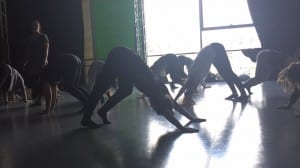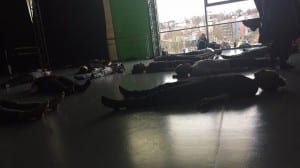Blog: Week Three 10/2/2016
As normal, the class started with us just checking in with our bodies and us starting to move slowly so that we are able to work out any stiffness we had. We then went onto an exercise called ‘Flocking’ which meant that we had to be aware of the other bodies in the space and involving each other in the decisions we made. This method linked with the mutual decision making from last week as it held a lot of the same qualities, for example, the movement was very similar as it remained quite slow and they were quite restricted, being mainly just lengthening of arms and slow steps. This pace allowed us to all stay together as a collective and we were all able to highlight the next movement as there was physically very little movement to focus on, however I noticed that as the pace increased the awareness of the bodies around us decreased and it became more frantic as there was more movement to concentrate on. It was clear that the order of the huddle decided on who the leaders were for the movement as it was the people around the edges, leader varied depending on the facing, which meant that it was obvious to the rest of the huddle who the leader was and it became more of a group effort and we were able to work together.
At the start of the pair task there was a lot of energy in the room, which is a common theme in all the methods we have used so far. The pairs were labelled A & B, and they were given words to tell their partner throughout their improvisations, like ‘change’ and ‘develop’. As I am becoming quite familiar with the bodies in the room and I know them all quite well I am able to identify their habitual movement, and in this task, I noticed a lot of new movement in the people who have quite recognisable habitual movement. In order to use the word ‘develop’ that they were given, there was a lot of repetition involved and the development of that material was clear to watch. When the dancers were given the word ‘change’ and then asked to isolate a body part of only move certain limbs, I was very surprised at the type of movement that was being performed by some of the dancers as I have never seen them move in that way and I wasn’t able to identify any habitual movement in what they were creating. Although, when there were elements of habitual movement, the dancers seemed more aware of it this week and were able to recognise when they were doing it and were able to change pathways or dynamic in order to avoid that familiar material. I was able to notice a lot of pauses in the dancer’s movement during ‘develop’ as it appeared that they lacked in confidence and were more hesitant and aware of themselves.
This method was then applied in a group context, all dancers labelled ‘A’ were in the middle of the space, and Kirsty gave directions to the dancers. Originally, there was very little isolation of body parts and the dancers were focusing mainly on the dynamic of their movement. Then they were given directions like:
‘No Arms’- In this direction I noticed a lot of similar movements between the dancers as they were being very careful in not including arms in their movements. There were a lot of pauses in this and the dancers seemed to be looking around at each other for inspiration. Like most of these methods, the dancers became more confident with their bodies and started to experiment more with levels and different ways of moving without their arms.
‘Left Hip’- This direction resulted in the dancers all originating with a similar hip rotation at the start of their movement and then the movement continued from there. This isolation didn’t appear as experimental as the others.
‘Slow Motion’- As the movement for this direction is slowed down, the dancers had more thinking time towards their next movement and it was much more placed and pre-empted. However, as the dancers had longer to think about their next movement, I would’ve thought they’d have reverted back to habitual movement but there was quite a lot of new movement which I was very surprised by as I’d presumed the dancers would’ve returned back to what felt comfortable in their bodies.
‘Fast’- For me, this direction is the most interesting to watch as the dancers find loads of different pathways unlike the tracking from last week. There was a lot of original movement in this direction and it felt very improvised as there is little thinking time for the dancers to pre-empt their next movement.
The second set of dancers, ‘Group B’ were surprisingly very different to the previous group, their movement dynamics between each other varied which was a very interesting quality to have within the group. It was visible within this group that they had thinking time within their movement as that was more apparent than the previous group. This group were also given direction:
‘No Arms’- The movement from this direction was very similar to ‘Group A’, the movement was quite hesitant and there wasn’t that much experimentation within the group as they all seemed to generate their movement from each other.
‘Right Elbow’- This direction surprised me the most as the dancers had very varied movements between each other but they all had the same quality of using opposites. I saw a reoccurring motion of using the left leg with their right elbow in their movement and it was hard to identify where this originated from, or how the dancers could be finding completely different movements with their elbows but they were incorporating their left leg.
‘Leading from the nose’- I found that there was a very similar sequential movement through the body from this direction as there was often a body roll starting from the nose and then there was movement that lead through the body. Although there was different movement as a result of the same starting point, the movement felt quite similar to each other as it held a lot of the same qualities.
‘Slow Motion’- As I expected, this direction had similar results to the previous group as it had the same thinking time for their next movement, although I did notice that some of the dancers who habitually move at a quicker pace, left less thinking time between their movements and perhaps didn’t perform the movement as ‘slow motion’ as possible.
‘Right leg/foot to stay on the floor’- The result of this direction was quite surprising for me as the dancers moved their improvisation to the floor, and I didn’t expect that to be the outcome of this direction. Once the dancers were on the floor, there was little to none level experimentation and most of the movement became about the arms as it was clear that their right leg and foot were on the floor.
Score
After the score was outlined to the dancers, it took a long time for the dancers to become confident in the space and there were a lot of the same dancers in the space each time. There was a lot of new movement from the dancers and they all seemed to be very aware of each other. It also appeared like there was a conscious decision made within the group whether to change the number of dancers in the space and they were able to sense when there needed to be another body in the space and when the movement was interesting enough with the bodies that were there already. I found the duets particularly interesting, especially when they were maybe just walking around the space together, as just from watching I was able to pick up a connection between the dancers that felt very comfortable to watch. I was able to pick up on the different groupings in the space, as I found that whilst there was a duet or trio, and a solo happening at the same time it was very interesting to watch and felt like that dynamic worked most in that space and the dancers were very aware of each other and therefore able to join in on each other’s movement flippantly. There were a lot of arm movements in this improvisation, presumably because they are easier for the others to copy and follow on, and there seemed to be a lot of habitual rolls at first as it appeared clear that others would be able to pick up on that movement fairly quickly in order to keep the same dynamic. The pace also changed a lot throughout the use of the score as there were so many different variations of the same movement from a changing number of people and within this, there was a very interesting development of the material as each person would adapt the same move in a different way. Habitual movement became apparent in the jam when one person had been leading for a long time, perhaps because they felt under pressure and were very aware of the people who were following them and they have confidence in their habitual movement. As expected, the dancers began to warm into the space when the score wasn’t applied and there wasn’t any restriction to the improvisations, dancers even made points of contact with each other and started developing relationships in the space. The whole improvisation became more experimental and explorative than I’d previously seen in the improv jam.

